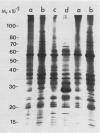Abstract
The ch4 mutant of sweetclover (Melilotus alba) has previously been demonstrated to be partially deficient in chlorophyll and to have a higher ratio of chlorophyll a to b than normal plants. We were able to substantiate these findings when plants were grown at 23°C and lower (permissive temperatures). However, when grown at 26°C (nonpermissive temperature) the plants produced small yellow leaves which exhibited one-twentieth the chlorophyll content of normal plants. Affected leaves did not increase their chlorophyll content when plants were incubated at permissive temperatures, but leaves which developed at the lower temperature contained increased amounts of chlorophyll. Similarly, only new leaves, not previously grown leaves, exhibited the yellow phenotype when the mutant plant was shifted from the permissive temperature to the nonpermissive temperature. Ribulose 1,5-bisphosphate carboxylase activity was decreased by half, relative to normal plants, in the mutant plants grown at the nonpermissive temperature, indicating that general protein synthesis was not greatly impaired and that the effect of the mutation was perhaps specific for chlorophyll content. HPLC analysis indicated that carotenoid content was not diminished to the same extent as chlorophyll and we have determined that the thylakoid protein kinase is not altered, as is the case for other chlorophyll b-deficient mutants. Experiments suggest that changes in photoperiod may be able to modulate the effect of temperature.
Full text
PDF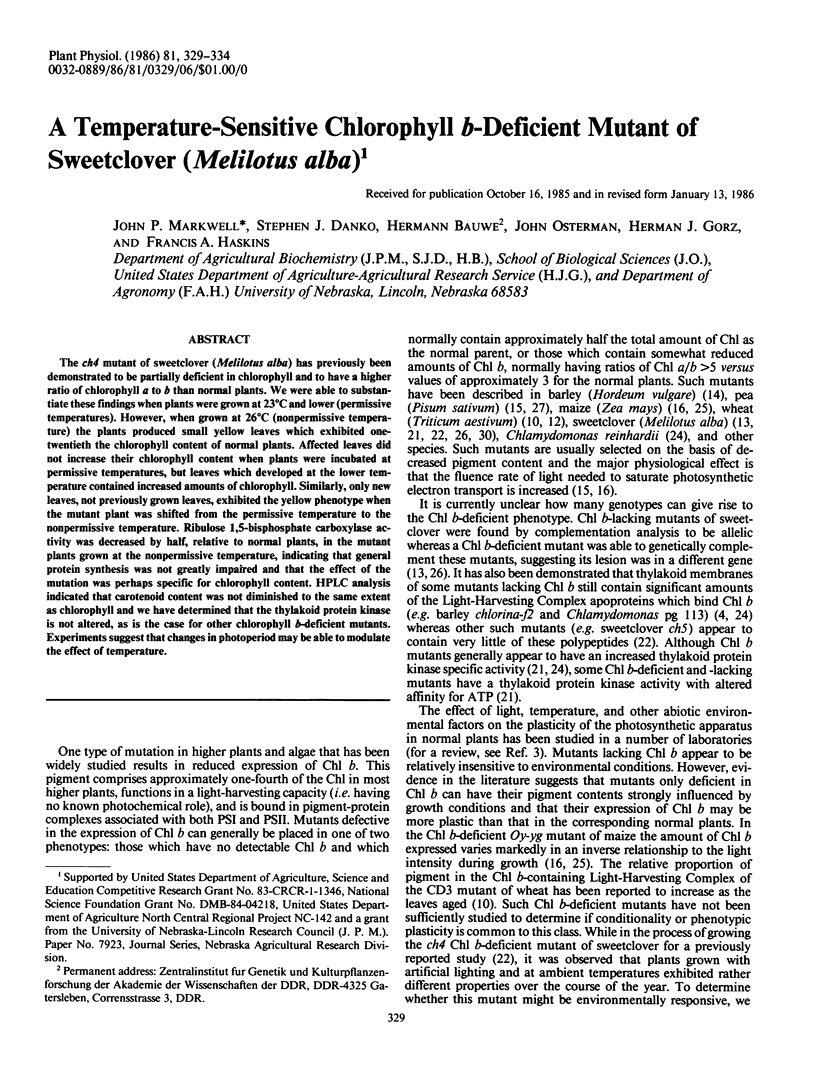

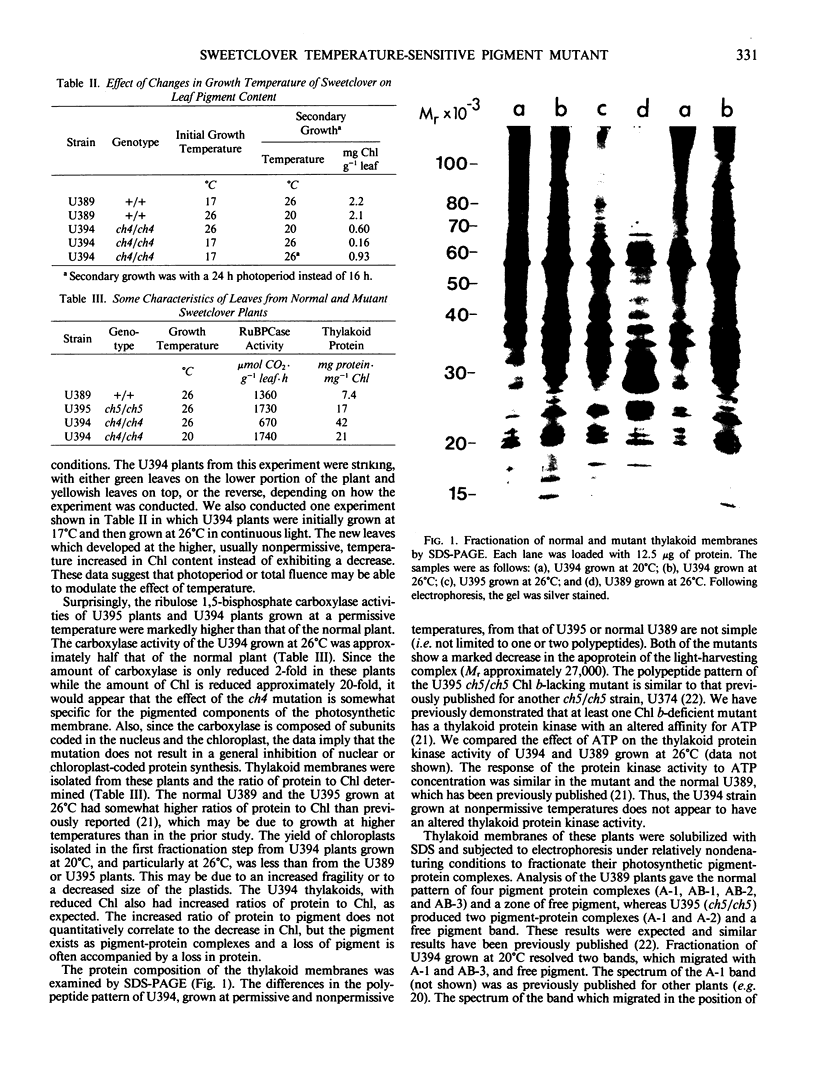
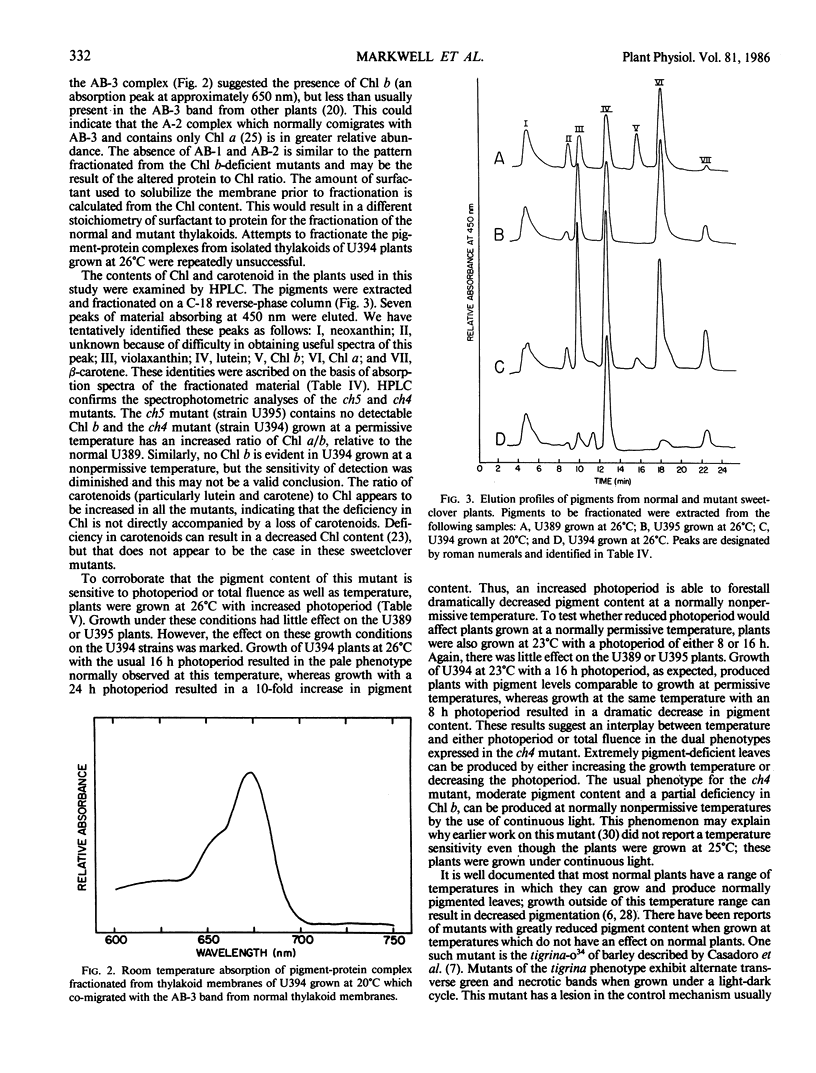
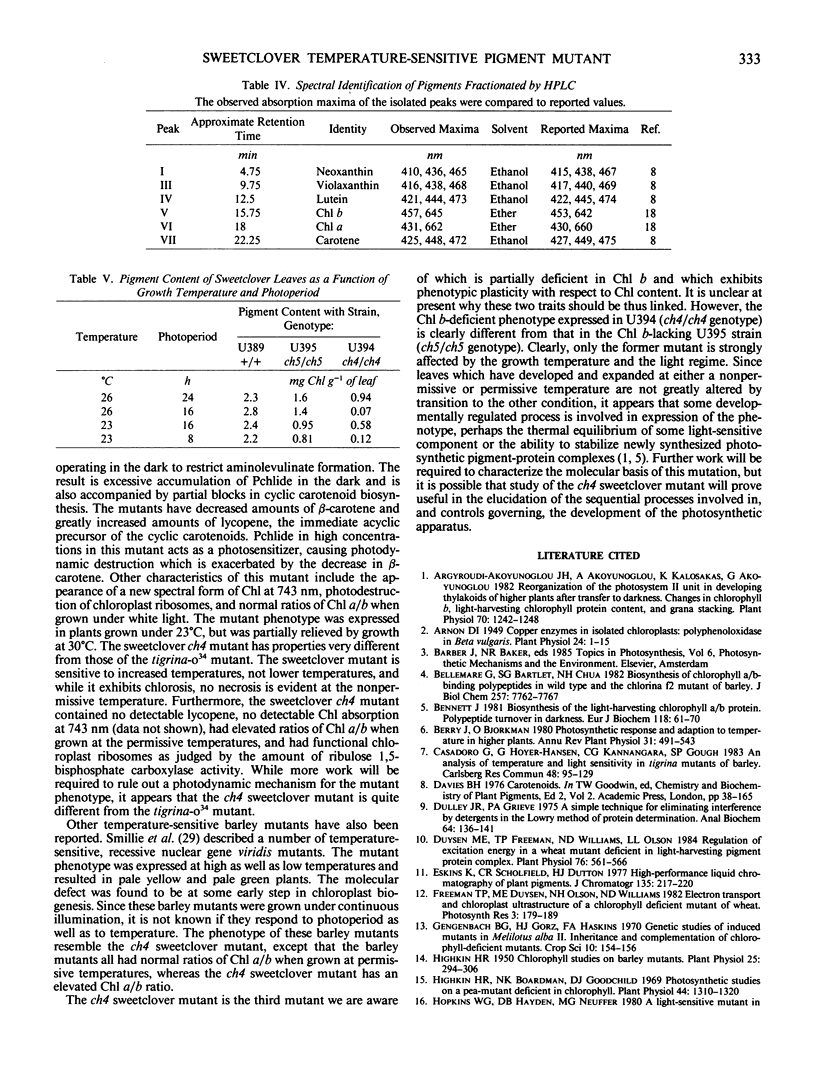
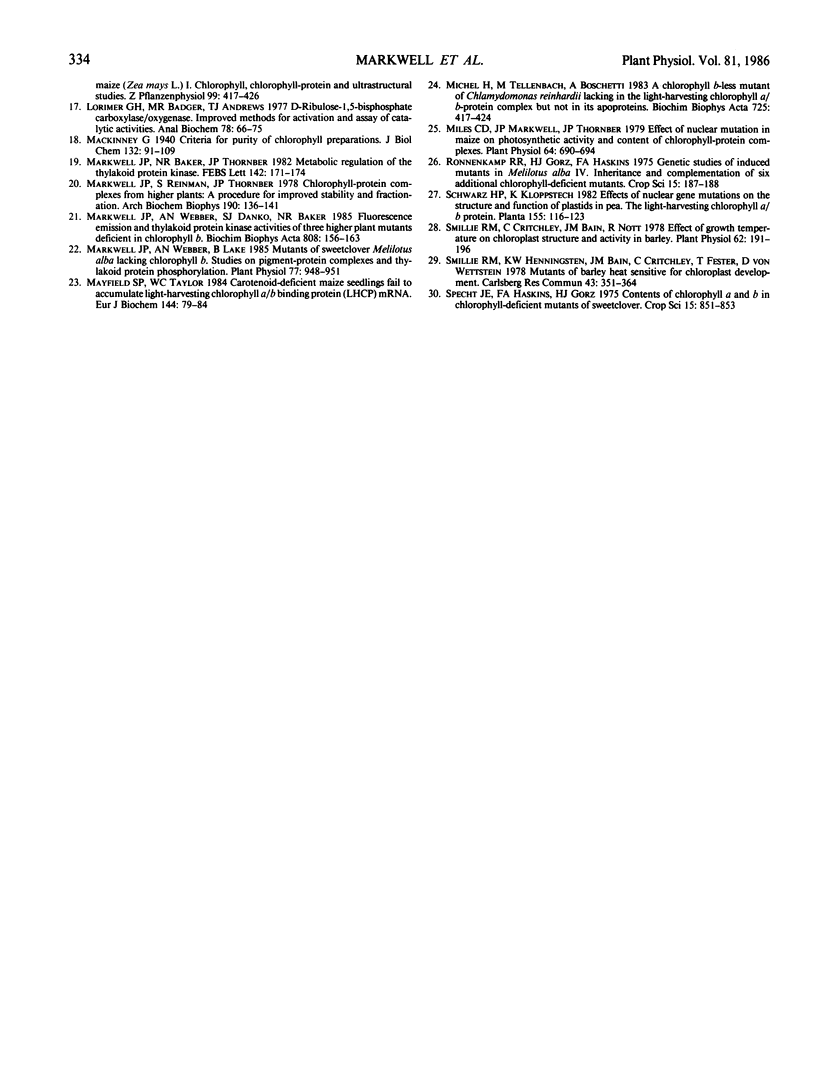
Images in this article
Selected References
These references are in PubMed. This may not be the complete list of references from this article.
- Argyroudi-Akoyunoglou J. H., Akoyunoglou A., Kalosakas K., Akoyunoglou G. Reorganization of the Photosystem II Unit in Developing Thylakoids of Higher Plants after Transfer to Darkness : Changes in Chlorophyll b, Light-Harvesting Chlorophyll Protein Content, and Grana Stacking. Plant Physiol. 1982 Nov;70(5):1242–1248. doi: 10.1104/pp.70.5.1242. [DOI] [PMC free article] [PubMed] [Google Scholar]
- Arnon D. I. COPPER ENZYMES IN ISOLATED CHLOROPLASTS. POLYPHENOLOXIDASE IN BETA VULGARIS. Plant Physiol. 1949 Jan;24(1):1–15. doi: 10.1104/pp.24.1.1. [DOI] [PMC free article] [PubMed] [Google Scholar]
- Bellemare G., Bartlett S. G., Chua N. H. Biosynthesis of chlorophyll a/b-binding polypeptides in wild type and the chlorina f2 mutant of barley. J Biol Chem. 1982 Jul 10;257(13):7762–7767. [PubMed] [Google Scholar]
- Dulley J. R., Grieve P. A. A simple technique for eliminating interference by detergents in the Lowry method of protein determination. Anal Biochem. 1975 Mar;64(1):136–141. doi: 10.1016/0003-2697(75)90415-7. [DOI] [PubMed] [Google Scholar]
- Duysen M. E., Freeman T. P., Williams N. D., Olson L. L. Regulation of excitation energy in a wheat mutant deficient in light-harvesting pigment protein complex. Plant Physiol. 1984 Nov;76(3):561–566. doi: 10.1104/pp.76.3.561. [DOI] [PMC free article] [PubMed] [Google Scholar]
- Highkin H. R., Boardman N. K., Goodchild D. J. Photosynthetic Studies on a Pea-mutant Deficient in Chlorophyll. Plant Physiol. 1969 Sep;44(9):1310–1320. doi: 10.1104/pp.44.9.1310. [DOI] [PMC free article] [PubMed] [Google Scholar]
- Highkin H. R. CHLOROPHYLL STUDIES ON BARLEY MUTANTS. Plant Physiol. 1950 Apr;25(2):294–306. doi: 10.1104/pp.25.2.294. [DOI] [PMC free article] [PubMed] [Google Scholar]
- Lorimer G. H., Badger M. R., Andrews T. J. D-Ribulose-1,5-bisphosphate carboxylase-oxygenase. Improved methods for the activation and assay of catalytic activities. Anal Biochem. 1977 Mar;78(1):66–75. doi: 10.1016/0003-2697(77)90009-4. [DOI] [PubMed] [Google Scholar]
- Markwell J. P., Reinman S., Thornber J. P. Chlorophyll-protein complexes from higher plants: a procedure for improved stability and fractionation. Arch Biochem Biophys. 1978 Sep;190(1):136–141. doi: 10.1016/0003-9861(78)90260-6. [DOI] [PubMed] [Google Scholar]
- Markwell J. P., Webber A. N., Lake B. Mutants of Sweetclover (Melilotus alba) Lacking Chlorophyll b: Studies on Pigment-Protein Complexes and Thylakoid Protein Phosphorylation. Plant Physiol. 1985 Apr;77(4):948–951. doi: 10.1104/pp.77.4.948. [DOI] [PMC free article] [PubMed] [Google Scholar]
- Mayfield S. P., Taylor W. C. Carotenoid-deficient maize seedlings fail to accumulate light-harvesting chlorophyll a/b binding protein (LHCP) mRNA. Eur J Biochem. 1984 Oct 1;144(1):79–84. doi: 10.1111/j.1432-1033.1984.tb08433.x. [DOI] [PubMed] [Google Scholar]
- Miles C. D., Markwell J. P., Thornber J. P. Effect of nuclear mutation in maize on photosynthetic activity and content of chlorophyll-protein complexes. Plant Physiol. 1979 Nov;64(5):690–694. doi: 10.1104/pp.64.5.690. [DOI] [PMC free article] [PubMed] [Google Scholar]
- Smillie R. M., Critchley C., Bain J. M., Nott R. Effect of growth temperature on chloroplast structure and activity in barley. Plant Physiol. 1978 Aug;62(2):191–196. doi: 10.1104/pp.62.2.191. [DOI] [PMC free article] [PubMed] [Google Scholar]



